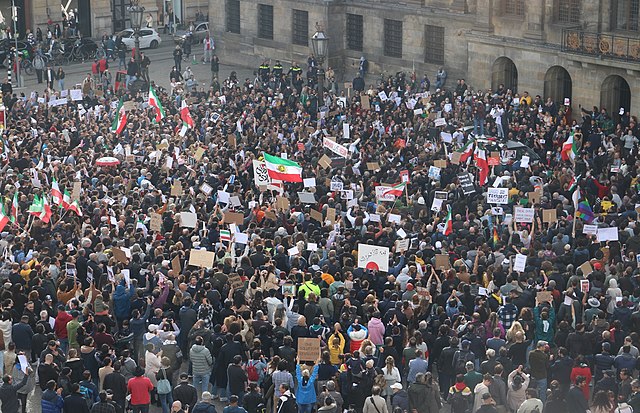
“Persian-Dutch community's demonstration in Amsterdam against the Islamic regime in Tehran,” CC-BY-SA 4.0, PHOTO BY PERSIAN DUTCH NETWORK Protesters in Amsterdam, the Netherlands march in solidarity with Iranian protesters. The protest, occurring on Oct. 1, was intended to show international support for women in Iran.
Iranian women protest for right to dress freely
Across the nation of Iran, women who have historically been forced to wear hijabs (a form of headscarf, intended to keep women modest under Islamic law) are protesting for their right to dress freely. Beginning on Sept. 16, a 22-year-old woman named Mahsa Amini was killed by the Iranian police by improperly wearing her hijab, sparking a chain of protests. Three days later, the Iranian government shut down internet access in certain areas, later escalating to blockage of communication apps such as Whatsapp or Instagram across the nation.
“Any person that thinks that the protests are justifiable and want[s] to help should make an effort to aid Iranian women,” sophomore Adam Weng said. “I think the people in the U.S. wouldn’t be able to directly interfere with the laws in Iran, but any source of support through funding or charity [would help].”
Although Iran has previously had civil unrest caused by mandatory hijabs, the protests after Amini’s death have had a more widespread impact on Iranian society. Both urban and rural citizens participated in the protests, as well as large numbers of school-aged girls for the first time.
“[Iranian citizens] have a right to protest,” sophomore Noah Gonzalez said, “but [the United States] tried for so long to fix their problems that it’s like they don’t want help. It’s not our problem anymore.”
The mandatory wearing of hijabs has been enforced in Iran since the revolution of 1979, where a relatively nonreligious monarchy was overthrown and replaced with a government based on the religion of Islam. Women have protested against hijabs multiple times since then, most notably in 2009, 2017, and 2019, but the Mahsa Amini protests have been more widespread than those. Multiple cities considered to be holy in Islam have seen protestors, unlike prior movements.
“I think the rallies and protests would help women in Iran,” junior Nhi Hua said. “One of the goals is rights for women, and the hijab law would hurt them.”
The Iranian government has downplayed much of the protests’ influence; Iranian Supreme Leader Ali Khameni called them “riots” and stated that they were a result of foreign influence. Counter-protests in support of government actions have adopted slogans such as “Death to America” and “Death to Israel,” following Khameni’s strategy of shifting blame to other countries for the current instability across the nation. Estimates range between 41 and over 260 fatalities, although the exact number cannot be confirmed.